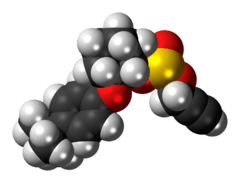Propargite
 | |
 | |
| Names | |
|---|---|
| IUPAC name
2-(4-tert-butylphenoxy)cyclohexyl prop-2-yne-1-sulfonate | |
| Other names
Omite, Comite, Uniroyal D014 | |
| Identifiers | |
| 2312-35-8 | |
| 3D model (Jmol) | Interactive image |
| ChEMBL | ChEMBL1416084 |
| ChemSpider | 4767 |
| ECHA InfoCard | 100.017.279 |
| KEGG | C18602 |
| PubChem | 4936 |
| |
| |
| Properties | |
| C19H26O4S | |
| Molar mass | 350.47 g·mol−1 |
| Appearance | dark amber viscous liquid |
| Density | 1.10 g/cm3 |
| 0.5 ppm | |
| Solubility | miscible in organic solvents |
| Hazards | |
| Safety data sheet | Cornell University |
| Except where otherwise noted, data are given for materials in their standard state (at 25 °C [77 °F], 100 kPa). | |
| Infobox references | |
Propargite (IUPAC name 2-(4-tert-butylphenoxy)cyclohexyl prop-2-yne-1-sulfonate, trade names Mitex, Omite and Comite) is a pesticide used to kill mites (an acaricide).[2] Symptoms of excessive exposure are eye and skin irritation, and possibly sensitization. It is highly toxic to amphibians, fish, and zooplankton, as well as having potential carcinogenity.[3][4]
References
- ↑ Lide, David R. (1998), Handbook of Chemistry and Physics (87 ed.), Boca Raton, FL: CRC Press, pp. 3–482, ISBN 0-8493-0594-2
- 1 2 "propargite (Omite, Comite) Chemical Fact Sheet 9/86". Cornell University. 1986-09-30. Retrieved 2009-12-02.
- ↑ http://www.pesticideinfo.org/Detail_Chemical.jsp?Rec_Id=PC34266
- ↑ http://www.epa.gov/iris/subst/0296.htm
External links
- Propargite in the Pesticide Properties DataBase (PPDB)
This article is issued from Wikipedia - version of the 7/30/2016. The text is available under the Creative Commons Attribution/Share Alike but additional terms may apply for the media files.